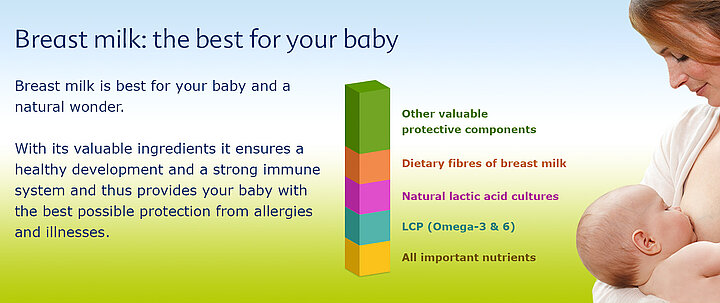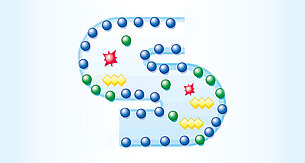What makes breast milk so valuable

All important nutrients

During the first few months, breast milk is the only provider of the most important nutrients a baby needs for a healthy growth. This is why it is particularly important that the mother’s diet is healthy and balanced. Fresh fruit, vegetables, wholemeal products, and fish at least once a week is important in order to supply babies well with vitamins, minerals, trace elements, and vital fatty acids.
According to paediatricians, only vitamin D and fluoride should be given in addition to breast milk as a prophylactic measure. In cases of vitamin D deficiency, the integration of calcium in the bones is impaired and could cause problems later in life. It is recommended that babies receive vitamin D daily in their first year of life.
It is also advisable that fluoride is supplemented to reduce the risk of tooth decay.
LCP (Omega3&6)

LCP (Omega3&6)) have an important role in the development of the brain, nervous system and eyesight.
LCP fatty acids (or LC-PUFA) are polyunsaturated fatty acids. They have an important role in the development of the brain, nervous system and eyesight. The most important LCP fatty acids for healthy development are arachidon acid (AA) and docosahexaen acid (DHA). These can also be found in breast milk.
Omega-3 is particularly important in infants for the development of the brain and nerve cells. Since the brain grows and matures so substantially in the first 2 years of life, regular consumption of Omega-3 fatty acids is especially important: 0.5% of the daily energy intake of an infant should be covered by Omega-3 fatty acids.
Natural lactic acid cultures

Breast milk contains different lactic acid cultures that help breastfed infants develop healthy intestinal flora. Mothers pass on protective lactic acid cultures to their babies through breast milk. The natural protective cultures settle in the intestine and can prevent unwanted or harmful germs from spreading. Breastfed babies therefore build up a special protective shield since 70% of the immune system lies in the intestine.
Breast milk dietary fibres

Breast milk dietary fibres (breast milk oligosaccharides) serve as food for the protective lactic acid cultures and help them multiply, therefore contributing to healthy intestinal flora.
Other valuable protective components in breast milk

Babies get other valuable protective components from breast milk which contributes to their healthy development.
Here are some examples:
- Antibodies (immunoglobulins) or lysozymes: which has a direct effect on bacteria
- Antioxidants and various messenger substances: which helps to fight infection
- Lactoferrin: helps the body absorb iron and is effective against bacteria
- Not all the functions of some breast milk components are known.
- Many others have not yet been researched at all.




